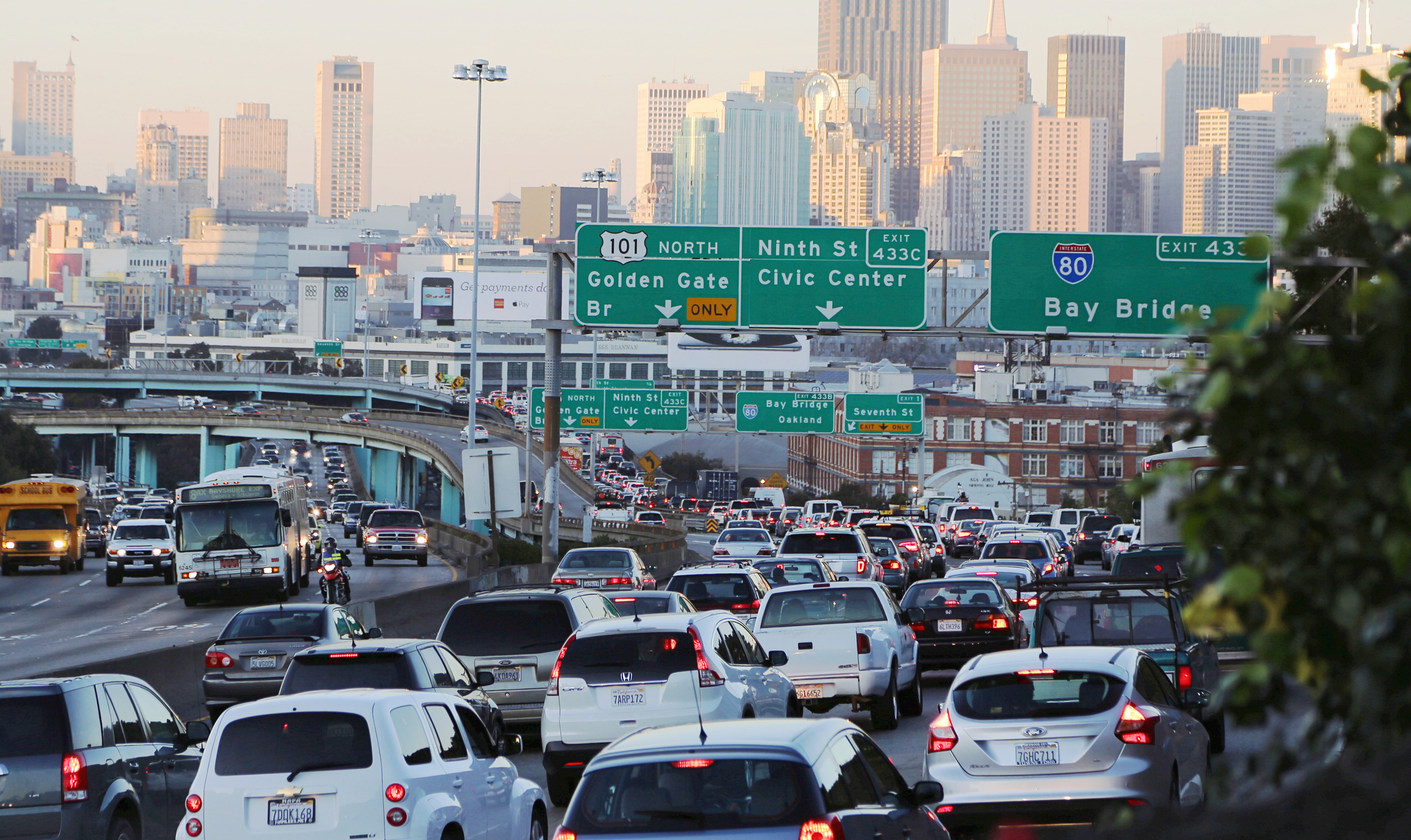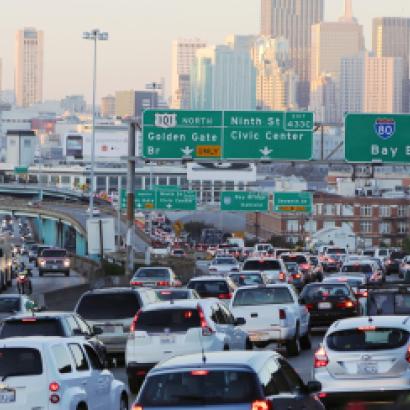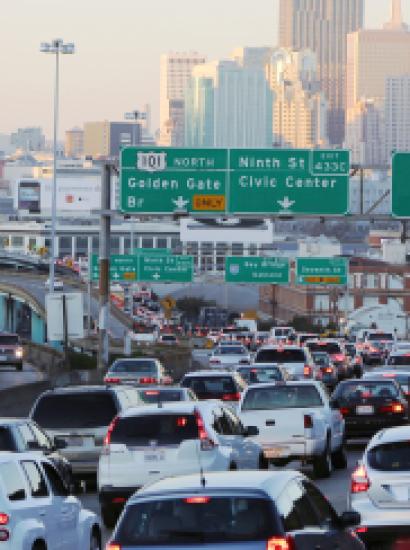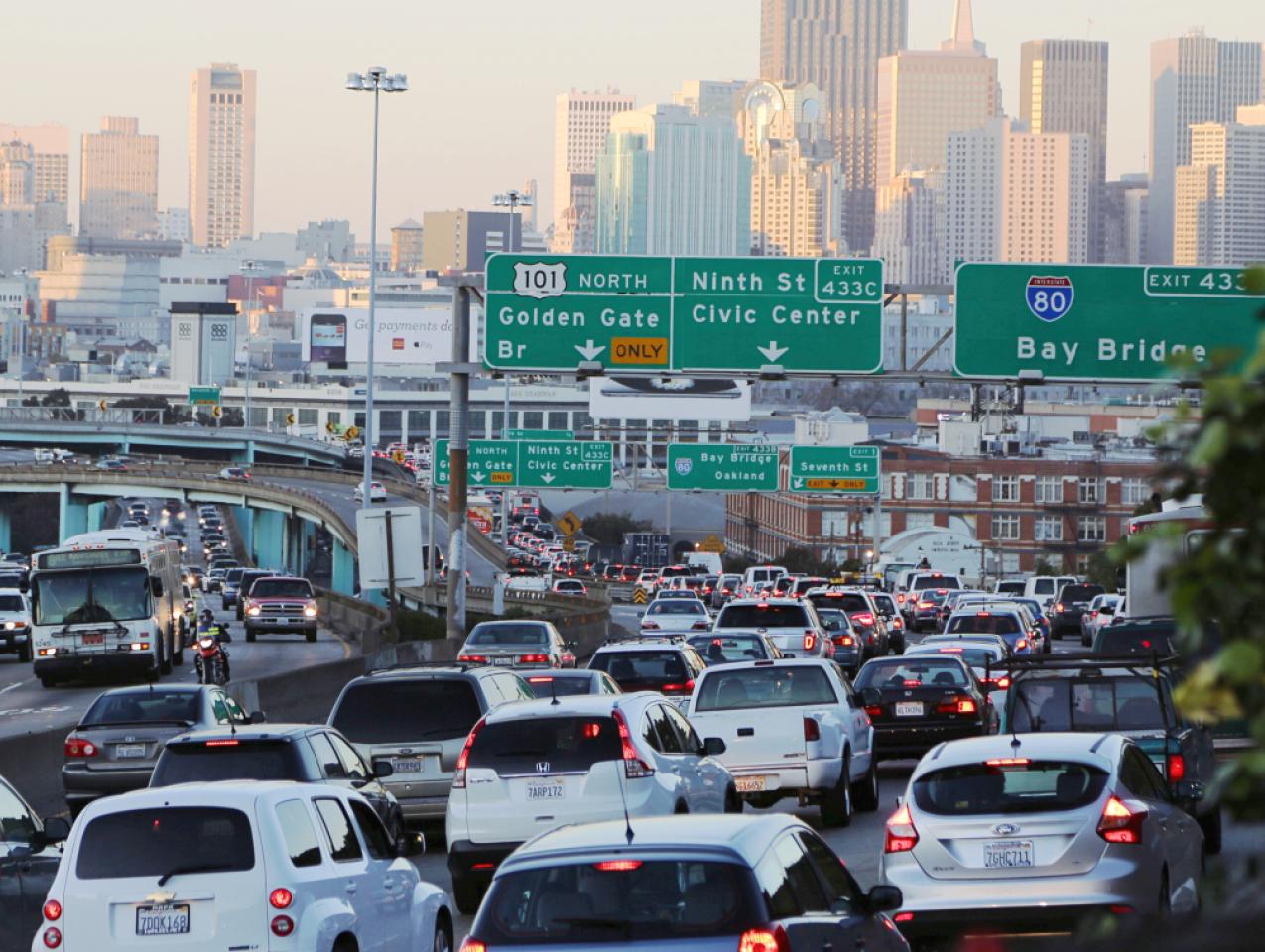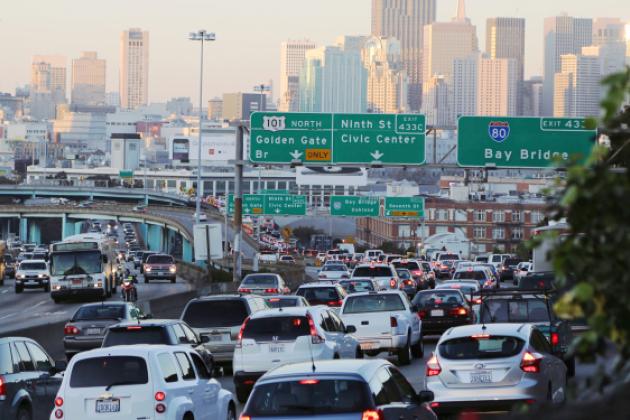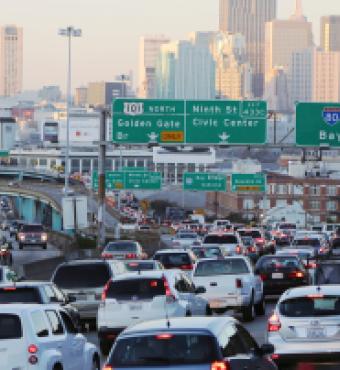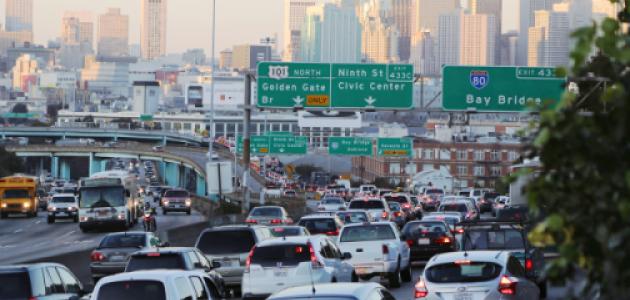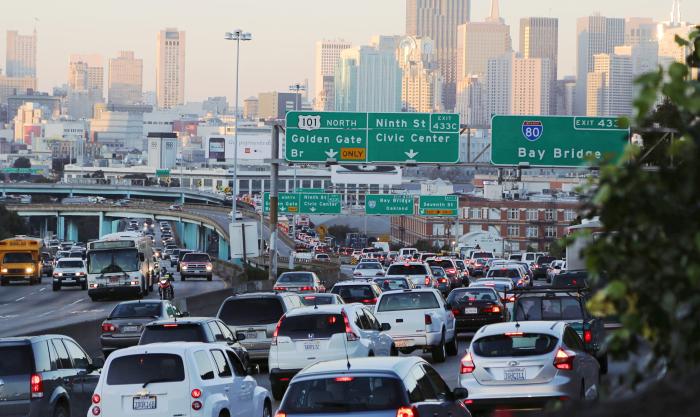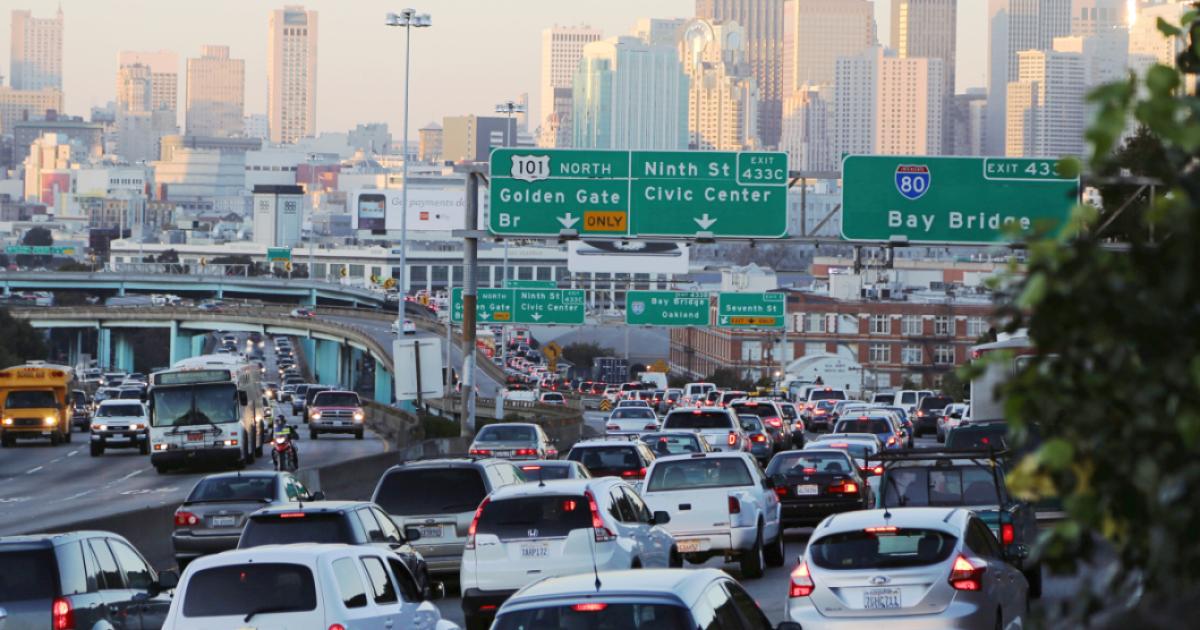- Politics, Institutions, and Public Opinion
- State & Local
- California
In a state whose locals are obsessed not only with curbing waste but trimming their waistlines, it should come as no surprise some lawmakers in Sacramento want to put California on a “road diet.”
Not to be confused with Atkins, South Beach, or Jenny Craig, a road diet basically implements Yogi Berra’s maxim that “No one goes there nowadays, it’s too crowded.” Another way to look at it is tough love. Halting road and highway expansion will create more congestion, which will convince drivers to seek out more efficient transportation options, such as transit, carpools, or relocation near their jobs or schools (or out of state).
As is the trend in California public policy, the road diet was inspired by the state’s consuming interest in reducing carbon emissions. Just last year, the legislature adopted a goal to reduce greenhouse gas (GHG) emissions by 40 percent below 2020 levels, which is in addition to an earlier law that capped 2020 emissions at 1990 levels.
The mildest expletive for that new goal is “ambitious.” Between 2020 and 2030, California must reduce GHG emissions by about 4 percent a year–double the pace of the last decade. This comes after having squeezed out the least costly energy efficiencies and increasing renewable electric power purchases to one-third the total portfolio, stopping import of coal-fired generation from out of state, and gaining the benefit of more-stringent national auto fuel economy standards.
California also initiated a first in the nation cap-and-trade program covering the state’s four hundred largest carbon-emitting facilities, which include fossil fuel power plants as well as motor vehicle fuels.
Those were the easy steps. The decade beginning 2020 will bring much more stringent and expensive compliance requirements and lifestyle changes to California businesses and residents.
Planners and regulators devote their attention to the transportation sector because it makes up the largest chunk of GHG emissions. Key strategies include increasing fuel prices through the cap-and-trade market, mandating less carbon-intensive fuels, and subsidizing the purchase of electric vehicles. But according to the California Air Resources Board, even more is required:
A reduction in the growth of VMT (vehicle miles traveled) is needed. VMT reductions are necessary to achieve the 2030 target and must be part of any strategy evaluated in this plan.
The bottom line, per the Air Board’s draft regulatory goal, is a 15 percent reduction in total light-duty VMT by 2050. (Note that even though last year’s legislation creates a 2030 goal, regulators use a 2050 benchmark for many of their regulations, using executive orders signed by Governor Jerry Brown and his predecessor, Arnold Schwarzenegger.)
To put the Air Board’s dictum in perspective, this chart illustrates how a 15 percent reduction in passenger car and light truck vehicle travel would change driving behavior. (The illustration assumes the reduction starts in 2021 and continues through 2040.)
The policy would require an absolute cut in per-capita mileage, meaning that on average California residents will need to figure out how to commute, get to school, and manage their daily lives while driving fewer miles. California businesses would need to figure out how to deliver more goods to a larger population during the next two decades, while projecting to add another 6.5 million residents and [to export markets?] while driving fewer miles.
The Governor’s Office of Planning and Research (OPR) has taken the road diet to another level: incorporating the principle into the state’s most powerful land use tool, the California Environmental Quality Act (CEQA).
According to a draft OPR regulation that provides guidance in the interpretation of CEQA,
Reducing roadway capacity (i.e., a “road diet”) will generally reduce VMT and therefore is presumed to cause a less than significant impact on transportation. Building new roadways, adding roadway capacity in congested areas, or adding roadway capacity to areas where congestion is expected in the future, typically induces additional vehicle travel.
Since additional VMT would be a “significant effect” under CEQA, agencies will need to mitigate those effects for these new projects, whether they are road capacity improvements, new housing developments, or job-creating commercial investments.
The short-term and intended effect of these policies will be to dissuade investment in projects that create more traffic or rely on expanded transportation infrastructure. But the long plan is to alter fundamentally California’s land-use policy and priorities from a tradition of meeting housing demand with a diverse menu of housing choices and price points to a laser focus on creating dense, urban housing near transit hubs, without regard to affordability.
The Air Board’s plan sets the terms of this new land-use regime. It proposes additional actions to be undertaken by state and local officials that would further discourage automobile trips:
- Accelerating equitable and affordable transit-oriented and infill development through new and enhanced financing and policy incentives and mechanisms.
- Promoting stronger boundaries to suburban growth through enhanced support for sprawl containment mechanisms, including urban growth boundaries and transfer of development rights programs.
- Identifying performance criteria for transportation and other infrastructure investments, to ensure alignment with GHG reduction goals and other State policy priorities, and improve proximity, expanded access to transit, shared mobility, and active transportation choices.
- Promoting efficient development patterns that maximize protection of natural and working lands.
In principle, a greater emphasis on urban infill housing seems like a good idea. After all, reducing transportation burdens and conserving farmland or open space are important attributes.
But the natural consequence of directing development into urban areas and away from suburban or greenfield areas is to ratchet up even further the price of housing in the job centers. When the price of close-in housing inevitably rises, more workers will inevitably seek affordable housing further afield, thereby increasing commute times and cars on the road.
This chart shows the coastal/inland dichotomy on housing prices. Living and working in metropolitan areas (which also make up the bulk of the state’s employment) is becoming less affordable as housing production falls further behind job creation and population growth.
Regulatory infill policy contains the seeds of its own destruction. When government creates scarcity, prices will rise. A housing policy that favors dense urban development and discourages regional housing solutions (urban limit lines, differential CEQA burdens on outlying projects, infrastructure improvements that favor infill development) will price out low- and middle-income Californians, who will seek more-affordable housing options further from the favored urban (and jobs) center. After all, an urban growth boundary creates an economic distinction, not a literal wall preventing commutes from outlying areas.
But don’t take my word for it.
The nonpartisan California legislative analyst found a direct relationship between housing costs and commute times.
Our analysis found that many important factors have statistically significant effects on commute times. These include whether the commuter drives, walks, or takes public transit to work; the metro areas land size, population, and density; the metro’s median income; and weather. After controlling for these factors–in essence isolating the effect of housing costs on commute times–a 10 percent increase in a metro’s median rent is associated with a 4.5 percent increase in individual commute times.
Using US census data, a transportation researcher looking at the San Diego region found that
Housing costs have repelled many prospective migrants, and at the same time encouraged residents to relocate to Riverside County. Disproportionately, those leaving San Diego for Riverside are low-income people, not well-off homeowners chasing a bigger house. . . For the foreseeable future, people leaving the county for the Inland Empire will be facing long, unreliable, expensive commutes.
Perhaps most insidious is the antidemocratic nature of the road diet. Creating a new course of action under CEQA for increased miles driven will undermine new, voter-approved local transportation projects. Throughout the state voters have agreed to increase their sales taxes in return for specific improvements in local streets and highways.
Just last month the legislature narrowly approved the first fuel tax increase in decades, with promises to improve the state transportation network. Whether these improvements can survive the Scylla of climate policy and the Charybdis of CEQA will be a momentous test of political will by California leaders.
After many years of mostly theoretical debate over the direction of California under ambitious climate change policies, real effects on ordinary Californians are now within sight. The road diet will be but the first of many new policies to constrain Californians’ lifestyle. Will it reshape our society for the better or starve middle-class Californians of new housing?

CALIFORNIA’S LOVE AFFAIR WITH THE CAR
If Detroit’s the Motor City, then California would be the Motor State. In the first quarter of 2017, registrations for new cars sold in the Golden State exceeded 500,000–the twenty-second consecutive year-to-year increase in quarterly registrations.
Each year the state’s nearly 25 million registered automobiles account for nearly $5 billion worth of registration and vehicle license fees dumped into Sacramento’s coffers. Evidence that, even in no-fault divorce California, breaking up is hard to do? The average vehicle on California’s roads is eleven years of age. Chalk it up to good weather, poor transportation alternatives, and a car-culture mentality but certainly not cheap gasoline prices.
NOT THAT WE SAW IT COMING DOWN THE ROAD, BUT . . .
A year ago, our Hoover Golden State Poll asked Californians if they’d be willing to switch from a tax at the pump to a tax on miles driven. The results were that fifty-three percent said no to the idea. When told the gas tax is growing less effective as better fuel mileage means less revenue, voters remain dug in, even more so when privacy concerns over how the state would collect mileage data was added to the conversation. Where this leaves state lawmakers, now that they’ve raised California’s gas tax for the first time in twenty-three years, from eighteeen to thirty cents a gallon is, in auto sales nomenclature, trying to sell a new model while keeping last year’s model in the showroom.







